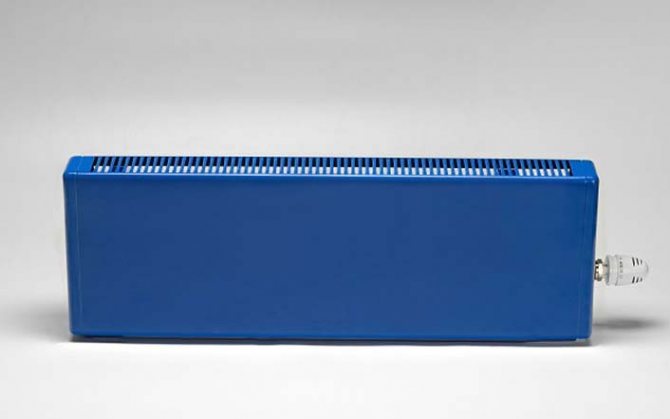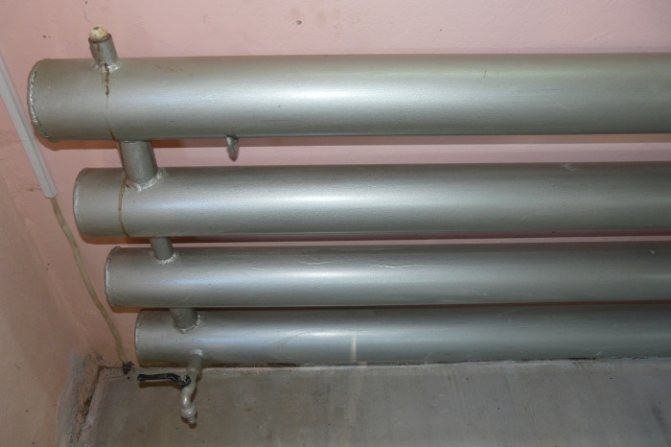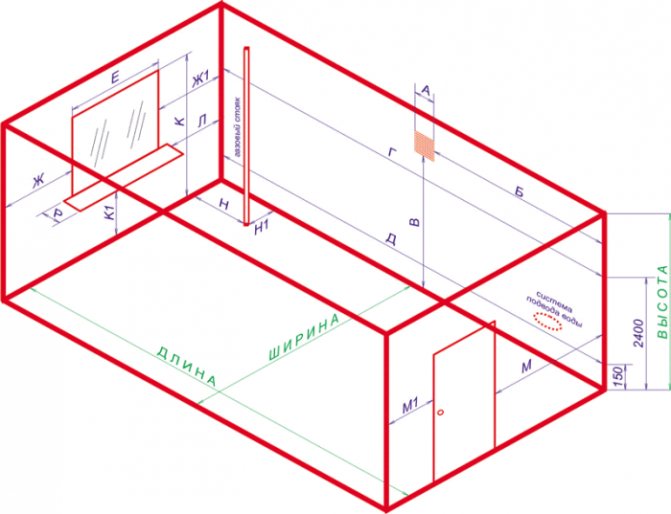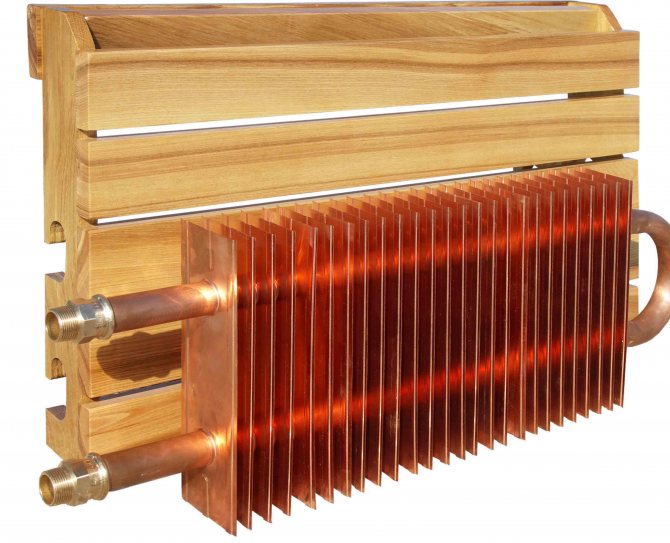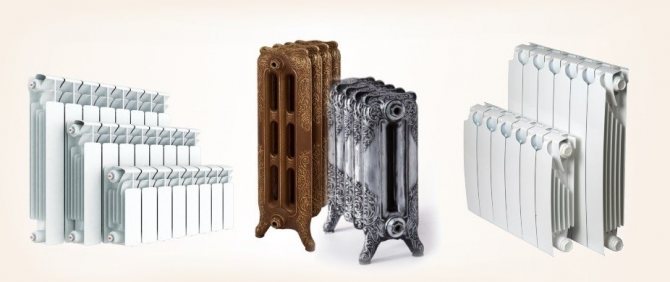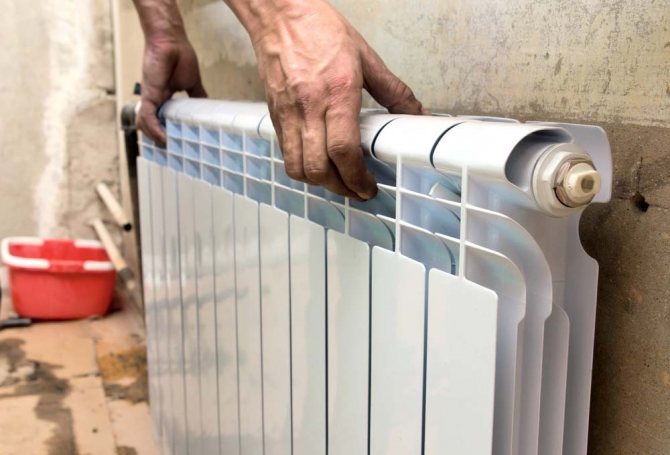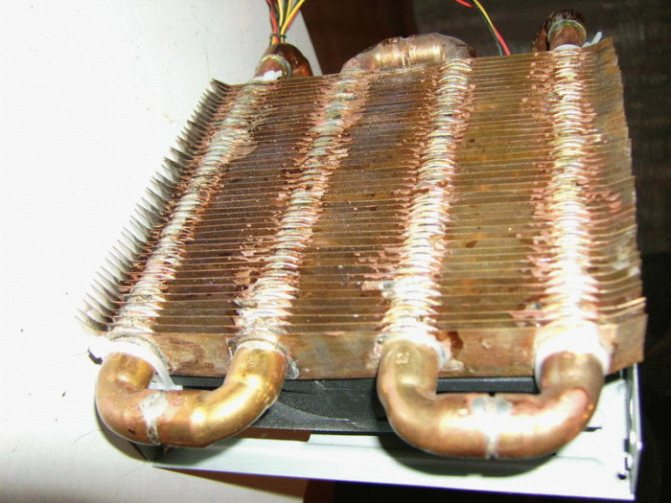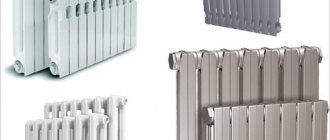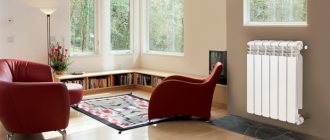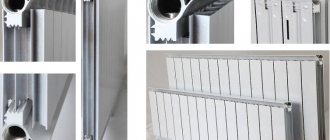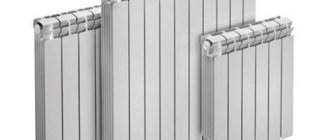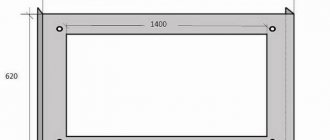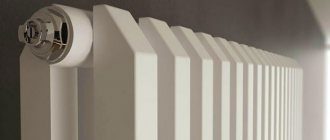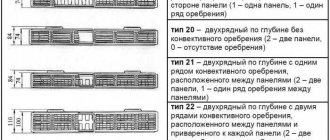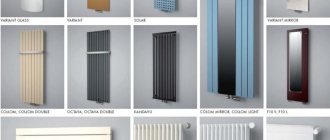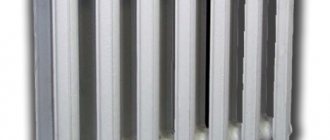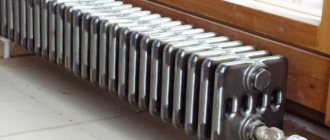Design features of copper radiators
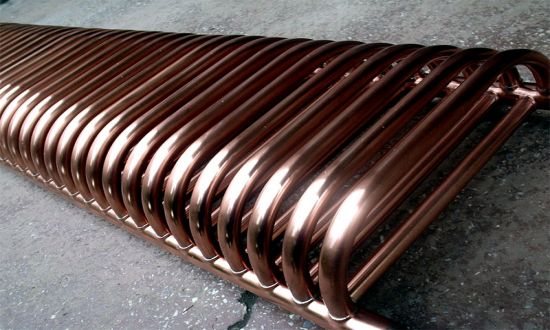
Copper radiators last longer as they are not subject to corrosion
The use of copper with a minimum amount of impurity allows you to reveal all the advantages of the material. Non-ferrous metal is not afraid of corrosion, it is strong and soft at the same time. The attractive appearance of copper batteries does not require painting. Heating devices are manufactured in various versions. Their design features affect the level of heat transfer.
Radiators are made of copper pipes of various diameters. To increase the area of heat transfer, row plates of non-ferrous metal are welded to them. Tubular elements come in horizontal and vertical directions. The devices consist of several sections. The number of pipes and plates depends on the model. There are options on the market with a protective cover made of metal or wood. Decorative cladding is matched to the interior of the home owners.
What do you need to make?
Despite the fact that the price of a modern heating battery is not so high, you can do without buying such devices, because you can handle their assembly yourself.
In this article, we will talk about how and with what materials homemade batteries can be made, which, in terms of energy efficiency, will practically not be inferior to factory counterparts.
"Warm plinth" made of copper pipes
It is clear that not every person can assemble a home-made oil radiator, since such a structure is complicated, but it is not so difficult to make a device through which water circulates as a coolant.
"Warm floor" - a kind of radiators
According to the principle of operation, homemade heating devices also do not differ from factory counterparts, however, it is not recommended to install these products in centralized systems with high pressure.
Homemade pipe heating radiators are the most common type of hand-made heating devices. And this is not surprising, since it is much easier to solder a sealed system from a pipe than to make a heater using factory technologies.
Products assembled from a single pipe or pipe combination are called a register. The register is a sealed system through which one or another coolant circulates. The energy efficiency of the register is determined by the diameter and configuration of the pipes, as well as the material from which they are made.
The practice of assembling radiators with your own hands shows that the most expedient solution is to use smooth-walled steel pipes with an inner cross-sectional diameter of 32-200 mm. In order to achieve the maximum area of the heat exchange surface while maintaining compact standard sizes, the device is shaped like a coil or the register is made sectional.
The choice of steel pipes for installation work is not accidental, since they are easy to cook with household welding machines.
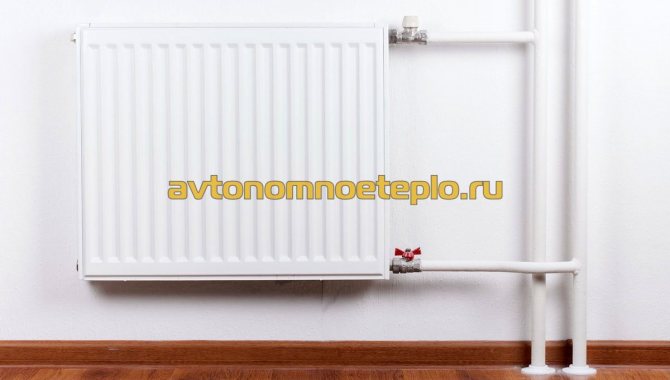

Advice: In order to make a register, it is not at all necessary to go to a metal base to purchase new pipes, because to carry out the planned work, you can use old pipes that do not have visible defects caused by mechanical deformation or corrosion.
Copper tube coil
Homemade heating radiators made of copper or steel can be made in two design options:
- Sectional registers consisting of straight pipes of large diameter with sealed plugs at the ends, connected by pipes with a smaller cross-sectional diameter.
- Coil registers with S-shaped or more complex configuration.
Important: For optimal heat dissipation, the coil register configuration should have a distance between adjacent pipes 5 cm larger than their diameter.
Let's consider in more detail the design features of the listed configurations:
- A sectional register consists of several pipes arranged horizontally.
Sectional register on the photo
For the circulation of the coolant, the horizontal elements of the register are interconnected by pipes of a smaller diameter. As a result, the coolant begins to move along the upper pipe, reaching the connecting pipe, through which it flows into the lower section, and so on.
In the factory version, such structures are made for heating entrances and other auxiliary premises, where the aesthetics of the appearance of the device is not so important.
The principle of operation of the sectional register
The location of the transition pipes is chosen as close as possible to the end of the section. This is done for better circulation of the coolant and to ensure greater strength of the prefabricated structure.
The optimal materials for self-assembly of sectional registers are galvanized steel pipes with an inner diameter of 76-160 mm. The structure should be cooked so that the tightness of the seams is maintained at an operating pressure of up to 13 atm.
Important: The optimal configuration of the register is the design in which there are no more than 3 horizontal sections. Excessive piling up of sections will lead to a decrease in the efficiency of heated air circulation inside the room.
- Serpentine registers are structurally similar to the breeding counterpart. The main difference is that the bending of the main pipe performs the function of the lintel here.
Coil welded from steel pipe and fittings
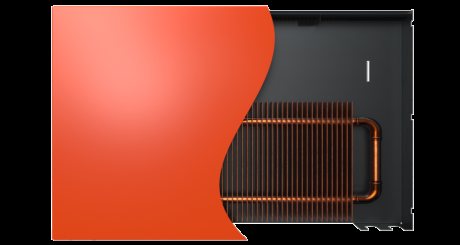

A significant drawback of coil structures is the complexity of self-assembly, since it is difficult to bend large-diameter pipes and therefore you have to cook two bends at each bend.
To make homemade heating radiators from a profile pipe, you will need a bending machine
As a result, the welded structure is complicated by a large number of seams, which can negatively affect the durability and tightness of the register.
Nevertheless, the S-shaped configuration of registers is an order of magnitude more efficient than the horizontal sections, since both the horizontal and vertical parts of the radiator participate in heating the air in the room. Moreover, due to the constant diameter in coil radiators, the hydraulic resistance is significantly lower than in sectional counterparts.
Choice of materials
Homemade copy with vertical sections
The duration of the service life, heat transfer, and finally, the price of a homemade radiator largely depends on the correct selection of production materials.
The choice of production materials is carried out in accordance with criteria such as ease of machining, simplicity and quality of welding, resistance to corrosive processors and price. In addition, if the radiator is being assembled for subsequent use in the bathroom, as a heated towel rail, the pipe should look good.
Homemade garage heater from a car radiator
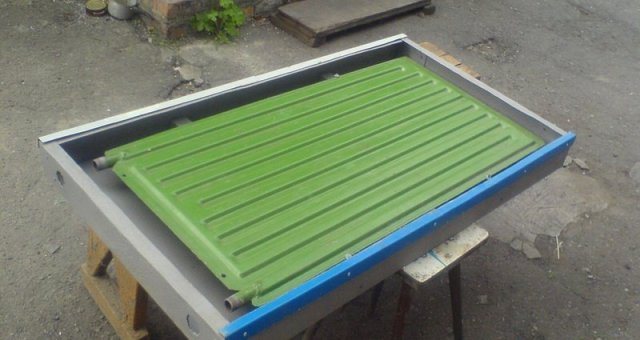

The conclusion can be made as follows:
- When assembling heating devices for operation and in entrances, garages and other utility rooms, it is advisable to use smooth-walled pipes made of ordinary structural steel of the St-3 grade.The wall thickness should be 2 mm, both for the strength of the entire structure and for the best quality of the weld.
- To assemble a heated towel rail, it is advisable to purchase more expensive pipes made of stainless steel AISI 304 (passport designation 08X17M10). As a result, the finished coil, subject to high-quality assembly, will look great due to the shiny surface and at the same time it will last an order of magnitude longer than an analogue assembled from ferrous metal due to its greater corrosion resistance.
The radiator assembly instructions also depend on the type of materials used. For example, conventional structural steel pipes are welded with conventional electrodes. For the assembly of stainless steel structures, it is better to use argon welding, since the use of conventional electrodes will not allow you to get a neat and outwardly attractive seam.
So, we found out what types of homemade radiators you can assemble with your own hands. In addition, we learned with what materials the assembly should be performed. The matter is small, it remains to purchase the necessary materials and assemble the heating device with your own hands.
Do you have questions that require additional clarification? In this case, we recommend watching the video in this article.
The easiest option in this regard is a steel pipe battery. In this case, it is not necessary to use a new pipe, you can buy a used one. The main thing is that it should be in good condition. What is needed in order to assemble a radiator with your own hands?
We suggest that you familiarize yourself with How to connect polypropylene to a heating radiator
From materials:
- pipe with a diameter of 100 mm;
- pipe with a diameter of 25 mm;
- steel sheet 3 mm thick;
- two squeegees with a diameter of 25 mm.
From tools:
- welding machine;
- Bulgarian;
- roulette;
- a hammer;
- marker.
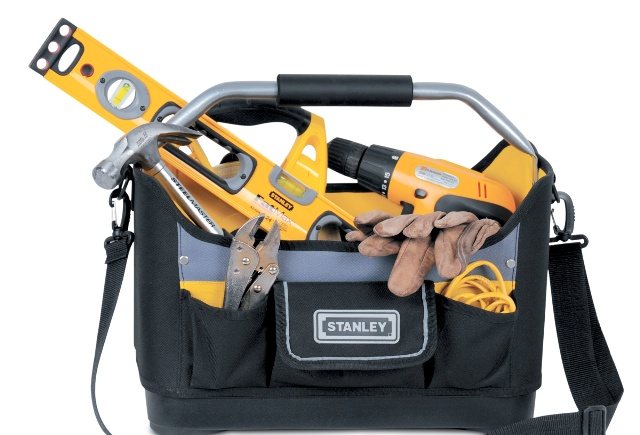

It is almost impossible to make a full-fledged analog of a factory radiator on your own. In particular, it will be difficult to perform finning, while achieving high heat transfer from the tube with the coolant to the fins. However, you can try to make a register out of pipes.
The effectiveness of such a device, of course, will be questionable (the small surface area is to blame for everything), but the appearance will be excellent. So, this option should only be considered as an effective filling of an empty niche in the house; the register cannot replace purchased batteries with 100%.
As for the manufacturing process itself, you can give several general recommendations:
- welding can be advised to connect the elements. It is undesirable to bend the pipes, as this will lead to a decrease in the wall thickness; it is not known whether it can withstand the pressure in the system;
- all pipes must be perfectly flat, you can pre-fix them in the tree;
- mandatory check for leaks;
- as a finishing treatment, it is advisable to cover the pipes with varnish, thanks to which the register can not be hidden, but used as a decoration of the room.
Of course, such an analogue of a battery, created by hand, in terms of thermal power, will be inferior to factory batteries. But such things are also created more out of love for creativity than because of the cold in the house.
Advantages and disadvantages
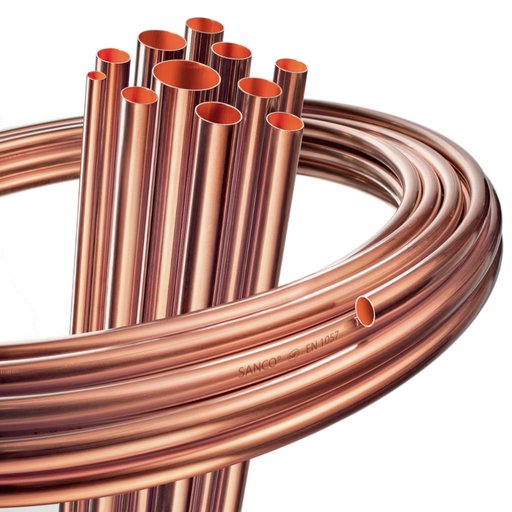

Copper pipes and radiators withstand pressures up to 16 atmospheres
Despite the high cost, copper batteries are installed in private houses and apartments. The popularity of the devices is justified by the advantages of the material:
- high level of heat transfer;
- long-term operation;
- pressure resistance up to 16 atmospheres;
- no deposits form on the inside of the pipes;
- coolant temperature up to 150 ° C;
- resistance to impurities in the coolant.
The soft metal does not leak when the pressure rises briefly. Copper batteries are lightweight and versatile.
Disadvantages:
- The devices are sensitive to abrasive particles. Their presence in the fluid flow accelerates the wear of the products.
- Ferrous metal fittings must not be used during installation. This leads to oxidation of copper.
- The high cost of copper radiators is a major drawback for most buyers.
Non-ferrous metal is not afraid of corrosion that occurs in contact with water and air. But copper products are susceptible to oxidation due to a chemical reaction on contact with aluminum or steel.
Internal corrosion
Many materials are prone to abrasion due to contact with a liquid that has either a high or a low pH. In this respect, such radiators compare favorably with others, because allow the use of a coolant with pH values from 4.5 to 12.5.
In addition, oxygen dissolved in the coolant causes corrosion. In this respect, copper-aluminum radiators have a high resistance, which exceeds even the corrosion resistance of cast iron batteries. Their service life is at least 40 years.
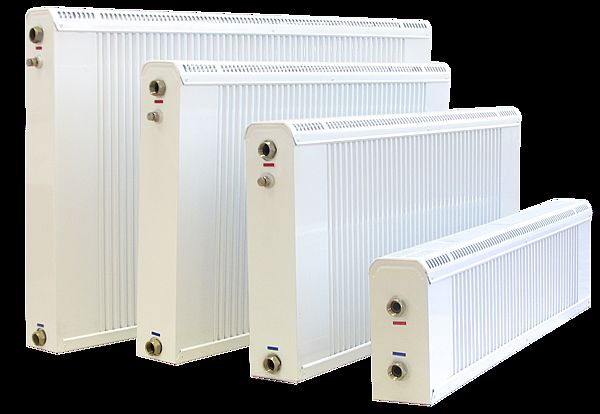

Radiators of different sizes
Principle of operation
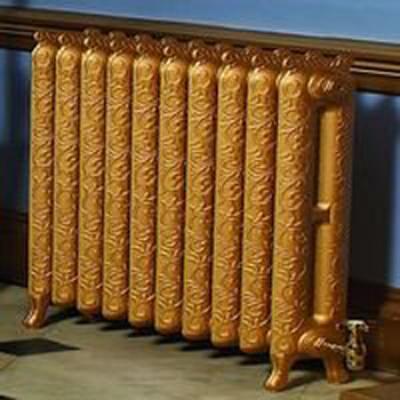

The temperature in copper radiators rises rapidly and warms up the room
Radiators are the part of the heating system that transfers heat. The liquid circulating in the circuit is heated in the boiler. It is piped to the batteries. The high temperature of the water will heat up the metal. Copper has a high thermal conductivity, the indicator exceeds the characteristics of steel several times. The work of radiators is based on physical processes:
- Thermal conductivity is the transfer of energy from heated bodies to colder ones. Pure copper, which is used in the manufacture of batteries, has a value of 401 W / (m * K). This is one of the highest values among metals.
- Thermal radiation - hot metal spreads infrared waves.
- Convection is the transfer of heat by a stream of air. Cold air masses pass through the radiator and their temperature rises. The heated stream rises to the ceiling. Heavy cold air takes its place, making the process continuous.
The copper radiator is highly efficient. Its characteristics ensure a rapid rise in room temperature.
Heat transfer principle
Heat transfer from the heating element to the inside of the room, which is heated, is carried out by means of heat radiation or convection. There is also a combined option - convection-radiating.
Heating devices that use radiation for heat transfer are sectional cast iron batteries or pipe radiators.
Convection heating devices transfer almost all the heat from the coolant through convection natural processes, i.e. due to air circulation inside the heated room throughout the volume from bottom to top.
In this case, the circulating air itself becomes a heat carrier when it passes through the heating elements of the heater. As a rule, the working surface of such elements has a ribbed surface.
Article on the topic: Underfloor heating and its connection to heating
These are the following types of devices:
- plate heating convectors;
- convectors with MA heat exchanger;
- copper-aluminum heating radiators.
During the operation of these devices, the circulation of air inside the room leads to the fact that the entire volume is heated evenly and there are no zones with different temperatures inside. In addition, the movement of layers inside the space evens out the humidity and normalizes this indicator.
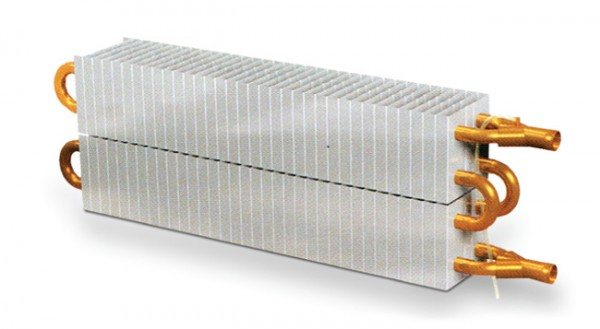

Copper-aluminum convector
Convection-emitting devices transfer heat in related proportions between convection and radiation.
Such devices include:
- panel steel radiators;
- aluminum sectional heating batteries.
Which battery to choose
The cost of radiators is not the last criterion when buying a device. Aluminum batteries are sensitive to the composition of the coolant, have a low operating pressure, and are sensitive to water hammer.They are not recommended for installation in apartments with central heating. Aluminum appliances will be the best budget solution for a private house. Copper batteries do not have the above disadvantages. They are effective, resistant to aggressive influences.
When choosing between copper and aluminum radiators for cooling, take into account related factors. The non-ferrous metal structure has a small diameter and corrodes faster. Aluminum tubes with a cross section 2 times larger are less likely to clog and last longer.
Methods for mounting copper radiators
To make efficient heating and not spoil the interior, choose one of two methods of installing batteries.
Wall mount
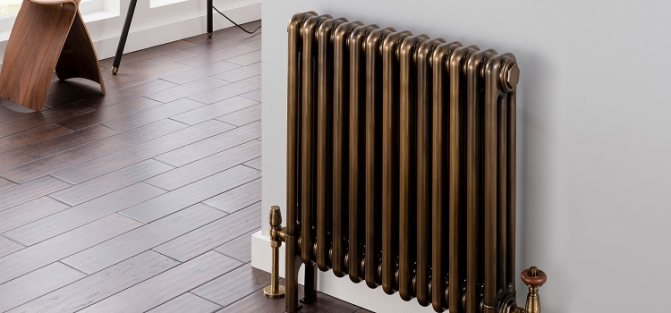

Copper radiator on legs with bottom connection
Brackets are used for wall mounting the batteries. They are fixed to the supporting structure and serve as the basis for the installation of heating devices. The best option for placing radiators is under the window. According to building codes, the length of the device should be 50-75% of the size of the window structure. The rules require batteries to be installed at a distance of 60-100 mm from the floor and 30-50 mm from the wall.
On legs
Floor placement has its advantages: the load on the wall is eliminated, and installation is simplified. Such models are popular in interiors with panoramic windows. They are installed in cottages, country houses, offices. The disadvantage of the batteries on the legs is the limited connection, only floor piping is suitable.
Sizing calculation
It is not very difficult to make a pipe heating device yourself. But here there is one important point - to correctly calculate the size of the device. After all, it is on them that such an indicator as heat transfer will depend.
The calculation is not easy, because it requires some criteria for the room itself. For example: the glazing area, the number of entrance doors, which windows are installed, whether the floor, walls and ceiling have been insulated.
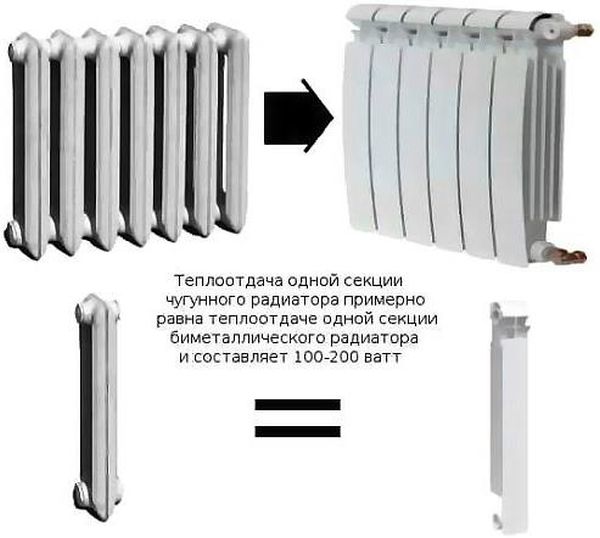

All this is difficult to take into account, so there is a simpler option, in which only two indicators are taken into account:
- area of the room.
- ceiling height.
How can this help when assembling a homemade heating device? To do this, you will have to make a comparison with a conventional cast-iron radiator of the MS-140-500 brand. The heat transfer of one section is 160 W, the volume is 1.45 liters. What does it give us?
You can determine exactly how many sections will be needed if you use a cast iron appliance. The total volume of the coolant that will be placed in one battery is determined from the number of sections. And knowing this number, you can approximately set the volume of the pipe radiator.
The thing is that the thermal conductivity of steel is 54 W / m * K, and that of cast iron is 46 W / m * K. That is, a small downward error will not have any effect on the quality of heat transfer.
Calculation example
We will conventionally assume that an eight-section cast-iron heater corresponds to the above-described ratio. Its volume is 8x1.45 = 11.6 liters.
Now you can calculate the length of a pipe with a diameter of 100 mm, which we will use to assemble a homemade battery. The cross-sectional area of the pipes is standard - 708.5 mm². We divide the volume by the cross-section, we get the length (we translate liters into mm³): 116000: 708.5 = 1640 mm. Or 1.64 m.
A slight deviation in both directions will not greatly affect the heat dissipation. Therefore, you can choose either 1.6 or 1.7 m.
Equipment for the installation of copper radiators
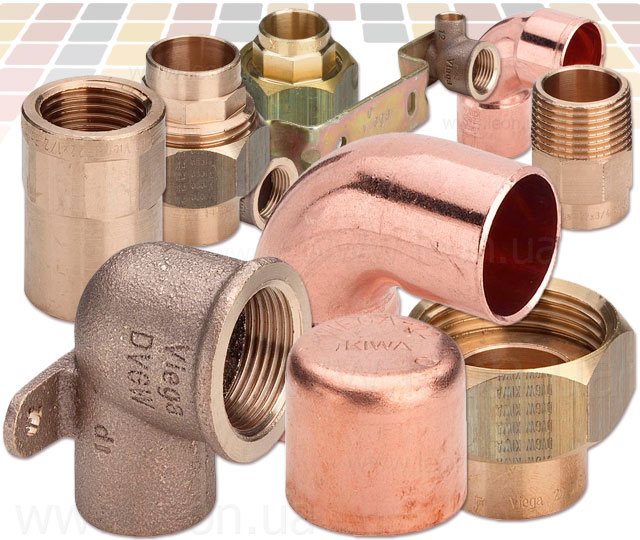

Shut-off valves can also be selected from a similar metal
One of the factors for the safe operation of the heating system is the installation of shut-off valves.
Mayevsky crane
For normal operation of the water heating system, the batteries must be equipped with a Mayevsky crane. This device serves to evacuate the air accumulated in the pipes. It is installed at the top of the battery.The shut-off valve is opened after starting the system in order to bleed trapped air and prevent the formation of plugs. After turning the valve one turn, a hiss characteristic of air outlet appears. The tap is kept open until a trickle of water appears.
Shut-off valves
Taps and valves are needed to adjust the amount of coolant in the batteries, as well as forced draining. Shut-off valves allow you to shut off the water flow in the event of a radiator breakdown. It is made of brass, the connection with the branch pipe is threaded. Thermostatic expansion valves, depending on the model, require manual override or are automatic.
Bypass
A bypass pipe is installed between the inlet and outlet lines. Its diameter is less than the cross-section of the pipes to be connected. The jumper allows the coolant to move around the battery. The element is typical for a one-pipe heating system. A tap can be installed on the bypass, then the movement of water is controlled.
When installing copper radiators, ferrous metal fittings must not be used. To avoid chemical reaction, all fittings must be made of brass.
Useful Tips
If the heating system of the house was assembled taking into account the use of forced movement of the coolant, that is, a circulation pump is installed in it, then the home-made device can be installed as you like (vertically or horizontally).
If in the heating system the coolant moves according to natural laws, then the battery must be mounted only horizontally. At the same time, there is no need to install an air vent (Mayevsky valve) on it.
You cannot make a high-quality radiator out of pipes if you have the skills to work with a welding machine at the beginner's level. It is necessary to boil the seams well, the safety of operation of the device and the entire heating system depends on this.
The thickness of a 100mm pipe must be at least 3.5mm.
Two squeegees can be welded to the ends of the pipes, where the metal pancakes were welded. In this case, the holes in the ends are made not in the middle, but with an offset: the inlet squeegee (upper) is closer to the upper edge of the pipe, the outlet (lower) is closer to the lower edge. It is better to make holes in the pancakes in advance, before welding them to the pipes.
When calculating heat transfer, there is no need to pay attention to the transfer area. It is clear that this figure will be higher for a cast-iron radiator. All this is offset by the high thermal conductivity of steel.
Weld seams should be cleaned and given a presentable appearance. To do this, scale and smudges are knocked down with a hammer, and the entire surface of the seams is grinded with a grinder.
Variety of copper radiators
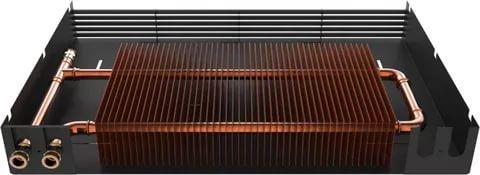

Copper plate radiator in a metal casing
When choosing a suitable option for radiators, it is worth evaluating their appearance and technical characteristics. The main one is the heat transfer of the device, it shows what area the device can heat. The batteries can be installed in rooms with high humidity. Various models of heated towel rails are available for bathrooms. In stores, there are copper radiators of domestic and imported production. Products from China are not recommended, they are cheaper due to the use of thin sheets of copper. Radiators are of limited service life. An alternative to buying an expensive radiator will be a bimetallic model. The heat carrier in them is made of copper, and the outer panels are made of aluminum.
Among the variety of heating devices, copper radiators stand out with a minimum of disadvantages. They are versatile in use and have high heat dissipation. The significant cost is the only minus of the devices.
Inertia of the heating system
The indicator of the inertia of the heating system determines how quickly the heating devices transfer heat from the coolant to the interior of the room that is being heated, as well as how long the system continues to heat the room after the end of the boiler operation.
Modern design criteria for heating systems, in which thermostatic equipment is used, imply a quick response of the heater when the temperature inside the room changes. It must quickly reach operating power and shut down without unnecessary heat loss.
The system, in which the regulation is fast, makes it possible to reduce heating costs by up to 20%, which is confirmed by the conducted observations.
The thermal inertia of heating devices (and the heating system as a whole) determines such a factor as the ability to quickly cool or heat up.
Factors Determining Thermal Inertia
- coefficient of thermal conductivity of the material from which the heater is made;
- the total volume of the coolant in the heating device.
Thermal conductivity is measured in W / m ° C. Below are the indicators of thermal conductivity for some materials from which heating devices are made:
- cast iron - 45;
- steel - 55;
- zinc - 100;
- aluminum - 230;
- copper - 420.
- cast iron radiator - 10 l;
- steel panel radiator - 3.5 l;
- aluminum radiator - 2.4 liters;
- bimetallic radiator - 1.5 l;
- copper-aluminum - 0.7 l.
The volume of the coolant in various heating devices
As you can see from the MA list, radiators have low thermal inertia. In other words, they heat up quickly and cool down just as quickly.
Radiator inside
Important! Significant cost savings during the operation of heating systems with a decrease in thermal inertia indicators are observed when using thermostatic valves. Therefore, MA radiators (which belong to non-inertial ones) must be equipped with appropriate equipment.
The lack of inertia, together with the high thermal conductivity of the materials from which the copper-aluminum radiators are made, make it possible to regulate the temperature in the heating system equipped with them quickly and efficiently (for example, when opening a window or when exposed to direct sunlight).
Related article: What is individual heating
How such radiators are arranged and used can be seen in the video:

